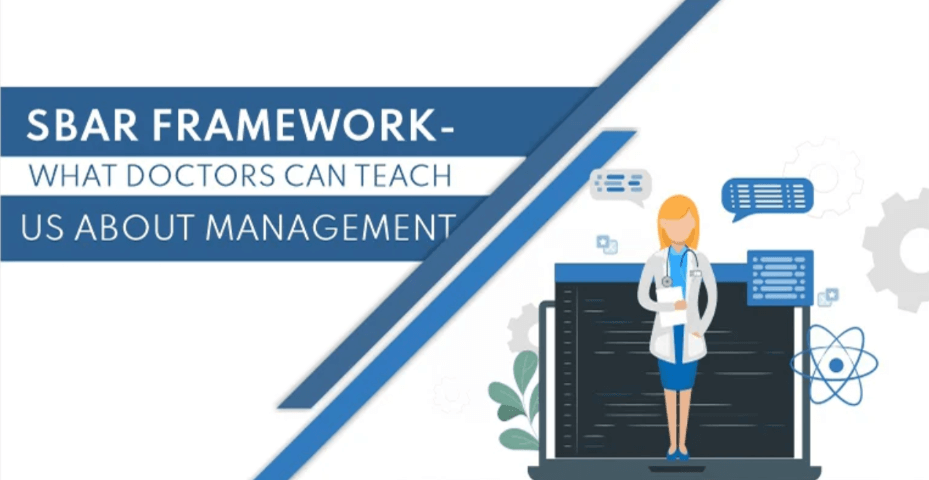
SBAR Framework- What Doctors Can Teach Us About Management
In this blog, we will discuss one of the best summarization frameworks to organize and communicate information – the SBAR.SBAR is a framework that can reduce confusion in information relay. The capacity to communicate clear and accurate information amongst individuals allows for better decision-making, time savings, and higher impact.
What is SBAR Framework?
SBAR stands for Situation, Background, Assessment, and Recommendation. Among organizations, it is the most dependable instrument for communicating information between individuals.
The SBAR framework was created in 2003 at Kaiser Permanente as a guide to assist healthcare practitioners in thinking about and solving health problems that demand immediate attention and response. During duty handoff, the US Submarine originated, structurally developed, and employed the term SBAR as a tool.
The SBAR framework is an easy-to-remember technique for framing interactions. It lets you specify what information should be transmitted between team members and how. It may also aid in the development of collaboration and the creation of a culture of open communication.
The tool comprises standardized prompt questions divided into four sections to ensure that employees deliver concise and focused information. It enables employees to speak assertively and effectively, reducing the need for repetition.
The tool assists workers in anticipating the information that colleagues will require and encourages evaluation skills. Team members are prompted to build content with the appropriate depth while using SBAR.
The SBAR is divided into four concise points that should fit on a single slide or piece of paper. Each segment should be a maximum of a couple of sentences long.
- SITUATION: This part concisely describes the present situation–the facts, no drama, and none of the symptoms. A simple statement that summarises what we know for certain about the current condition of situations.
- BACKGROUND: This section concisely explains the key background data points that should be considered when we choose how to proceed.
- ASSESSMENT: This section summarises the author’s evaluation of the present situation. If the “S” in SBAR stands for “WHAT,” then the “A” stands for “SO WHAT.” When reviewing this part, you have a fantastic chance to see an associate’s current level of critical-thinking abilities and obtain insight into his or her strengths and limitations in problem-solving.
- RECOMMENDATIONS: This section includes the suggested action and next actions. This advice must be focused on improving or resolving the problem while keeping the individual conditions in mind. It should be motivated by the evaluation.
Why Is SBAR Important?
To help you understand the importance of the SBAR framework, here we have listed a few key pointers:
- It helps to influence the employee’s thinking by eliminating emotional waste.
- Standardizes the way of thinking.
- It helps to make things more clear and developmental requirements more visible.
- At the moment, it can be used in real-world scenarios.
- It gives you a unique perspective on how people think.
- Most importantly, it makes the most significant use of your professional time and ensures that the job is done at the proper level — it allows you to return to leading rather than micro-managing.
Example Of SBAR In a Business Setting
We know for certain that we must devote our attention and efforts to the next best thing to accomplish to offer value and generate ideas that will allow us to succeed. When team members bring you their SBAR worksheets, they will have already processed through their job – they will have stepped out of the drama and truly cut down their tales, utilizing critical thinking to explain the problem from a neutral point.
It gives managers insight and a window into how associates think, where they need improvement, and how proficient they are in reality-based thinking — it keeps them fact-based and shows them where they need further information from coworkers.
When clinical professionals utilize the tool in their presentations, they suggest that the communication’s purpose is obvious. This is especially crucial in cases where personnel may be hesitant to make a recommendation, such as when they are inexperienced or need to interact with someone more senior than them.

Doctor
Who Should Use It?
Implementing SBAR clarifies communication and eliminates the unreliable practice of ‘hinting and hoping’ that the other person understands.
The SBAR is an excellent tool for structuring interactions and may be applied in a number of contexts in your presentations. You can use certain SBAR-related editable PowerPoint templates to:
- Anyone who has to quickly get to the core of the issue and the bottom of the problem.
- By any team leader who wants to put the famed “You got a minute?” to good use.
- Any manager who wants to ensure that a team member has already absorbed the information. It may be utilized as a guide for the associate’s thought processes and provide timely assistance, decisions, and approval.
Wrapping It Up
Communication could be defined as a two-way mutual understanding process in which participants communicate information and establish and share meaning. SBAR contributes to creating a structure for an interaction that benefits both the provider and the receiver of information.
It assists the donor by ensuring they have organized their thoughts before transmitting them to someone else. The receiver knows what to anticipate, which helps to guarantee that the information presenter is not interrupted by queries that will be answered later in the conversation.
SBAR can be used in any situation, but it is especially useful in lowering the barriers to good communication between disciplines and levels of an organization.





